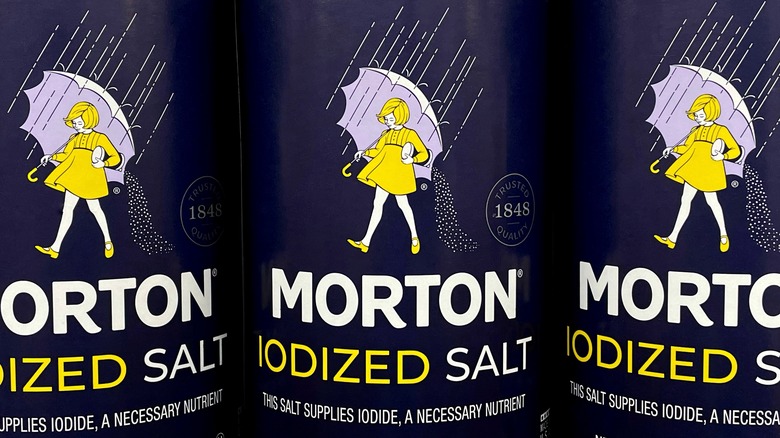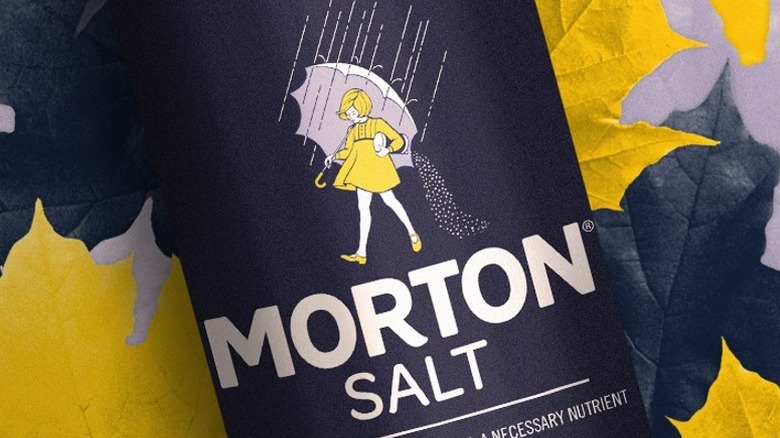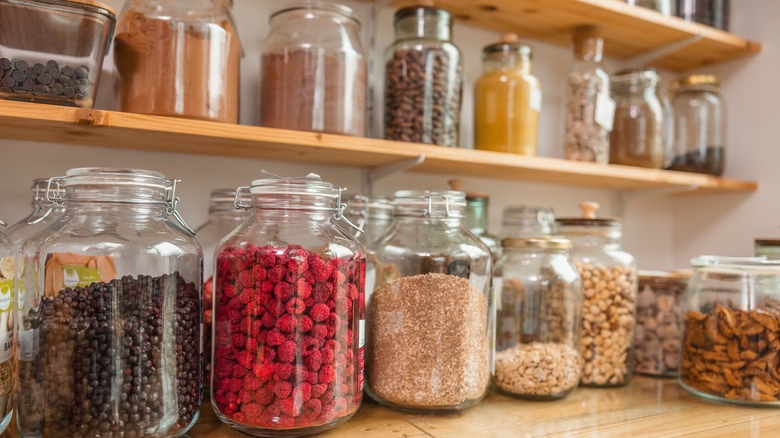The Big Mistake You've Probably Been Making With Morton Table Salt Boxes
If the word 'Morton's" sounds vaguely familiar to you, you probably have it sitting in a little shaker next to the pepper. Ever since its founding in 1889, Morton's has been the go-to brand name whenever you might need table salt, and that's no exaggeration! The company makes an incredible $17.0 million annually. That's certainly nothing to be salty about.
Morton's Salt almost always comes in a large round container, decorated with the iconic logo of a raincoat-wearing girl walking along through the rain as she spills salt behind her. Aside from the impressive logo, there's really nothing else you could probably say about it. It's a big container full of table salt. But the interesting part is actually located on top of the container itself. You'll notice a little metallic tab located directly on top of the count — flip that open with your thumb and you get a funnel that you can pour the salt out of.
Of course, many of you probably knew that already. It doesn't take a rocket scientist to open up a container of Morton's Salt and pour it into a salt shaker. And speaking of salt shakers, have you ever noticed that the container itself kind of looks like a salt shaker? Wouldn't it be great if you could just skip the whole process of refilling a salt shaker and use the container itself? If you've ever had that thought, then this trick is just for you.
You can convert the container into a salt shaker
While the metallic attachment may be good for funneling salt, it's not as good at seasoning your food as a salt shaker is. Go ahead and try to season your food using the funnel, then try it again because you've basically covered your whole meal in a mound of salt and need a new plate. With this trick, however, you can very easily turn your container of salt into a convenient, if not large, salt shaker.
As TikTok user trip82city details, once you flip out the little metal spout, you must then remove the piece of paper or sticker that's behind it, allowing you to lift up on the spout. At the bottom of the spout, you'll notice two small holes located across the surface. Press the spout back down, making sure that the bottom of the spout with the two holes is facing upward. In effect, you've flipped the spout upside-down. These two holes, however, are actually the perfect sizes for salt to pass through, much like the tops of your average salt shaker. When you grab the container and shake it, only a light sprinkling of salt will come out instead of a massive amount.
This is a very good way to avoid any messes, as you've likely had to clean up some spilled salt after every refilling of your shaker. It's even better if you don't have a shaker, since the container itself is one.
You could also use the lid as a shaker for other seasonings too
Once you turn your Morton's Salt container into its own shaker, you're most likely going to use every last granule of salt you can get out of it. When the last few pinches of salt are gone, you'll probably just want to toss the container out like usual. Before you do, it may surprise you to learn that you could recycle the lid and spout of the salt container and use it as a shaker for other spices and seasonings.
To recycle the lid, simply cut the top off the empty salt container, leaving the lid and the spout intact. Using a mason jar ring as a stencil, you can trace around the spout to make a smaller lid, cutting off the excess white cardboard. Once the lid has been "trimmed," it should be the exact size — if not a bit smaller — than the mason jar ring you used as a tracer. Put this new lid into the mason jar ring and then screw the assembled lid onto the mason jar of your choice.
The beauty of this trick is that it allows you to use the "pour" function of the spout to easily dispense sugar, flour, or other seasonings or powdered ingredients without having to scoop them out. You can then convert the spout into a shaker to dispense other ingredients without using too much, such as sprinkling powdered sugar onto French toast or flour onto bread.


